Modeling the Impacts of Invasive Streamside Plants and Food Availability on Brook Trout Feeding and Growth
The Brook Trout (Salvelinus fontinalis) is the New Hampshire State fish, the only native salmonid in the state, and an important component of stream ecosystems while being popular among recreational anglers. This research, funded by a Summer Undergraduate Research Fellowship (SURF), aimed to understand how an invasive
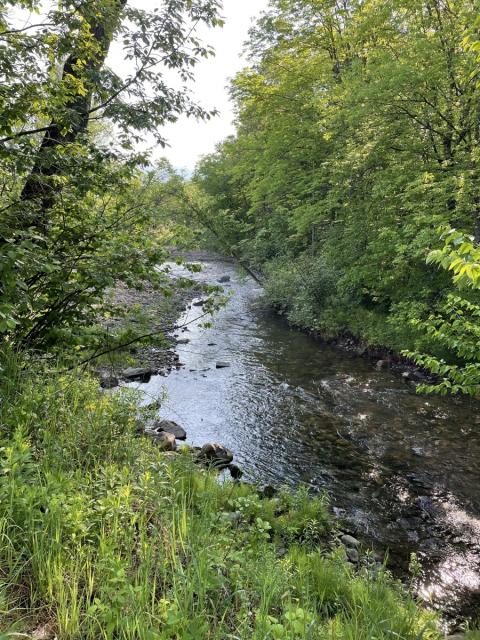
Garland Brook
streamside plant, Japanese knotweed (Fallopia japonica), might affect feeding opportunities for Brook Trout. These trout are often the apex predators in their habitats, structuring stream communities. In addition, because they can only survive in specific water conditions, Brook Trout are often used as an indicator of water quality. Therefore, quantifying what habitats are most valuable can inform native fish conservation and invasive species impact studies.
Brook Trout are native to Garland Brook, a small stream in Lancaster, New Hampshire, which is a tributary of the Connecticut River whose headwaters are in the White Mountains National Forest. Prior research at Garland Brook highlighted the impacts of knotweed on physical elements in the streamside environment (Hammer 2019). My study sheds light on potential impacts of knotweed on the organisms within the stream. Specifically, my project sought to 1) determine if Brook Trout food (stream macroinvertebrates) varied in composition or production between habitats impacted by knotweed and those with little presumed knotweed impact; 2) quantify the percent dry weight and energy density of stream macroinvertebrates to show how much energy Brook Trout will gain when feeding; and 3) use simulation models to predict how differences in physical habitat and prey availability might affect Brook Trout foraging success.
Methods
The main source of data for this project was collected from Garland Brook in 2021 by field technicians and other lab members, including my mentor, Dr. Furey. I assisted in continued data collection during the 2022 field season. At the stream, I performed habitat assessments to determine the water depth and flow rate among stream habitats. We measured flow rates by wading in the river using a flow meter, a vertically adjustable pressure-sensitive sensor attached on a metal rod, to record the flow (m/s) each 0.5-1 m across the stream. We measured depth using a meter stick, and I recorded water temperatures using HOBO temperature loggers (Onset).
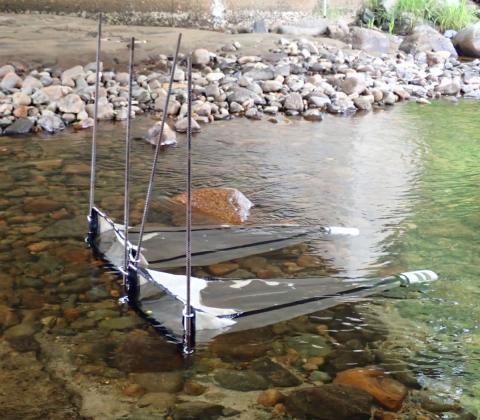
Drift nets
To collect macroinvertebrates from the stream, I used a combination of drift nets and a Surber sampler. A Surber sampler is a fine-mesh net attached to a small metal quadrat which is placed in a stationary location at each site. Drift nets are fine-mesh nets which taper out into a cod-end. These are deployed at each site in the part of the stream with the fastest moving water, with the opening in the net facing upstream and held in place with two rebars. These nets stay in the water for approximately fifteen minutes at each site before being recovered. I then sorted the contents from the Surber sampler and drift nets and placed them in containers with ethanol to preserve them.
I brought the macroinvertebrates back to the lab to process. Individual invertebrates were measured and identified to order. I recorded data in Excel and the abundance of macroinvertebrates at each site was divided by the total volume of water that passed through the nets (calculated from water depth and measured flow at the site) to obtain the drift production (density of invertebrates per m3/s) for each site.
I placed select individuals in a drying oven to calculate percent dry weights. I then made the dried samples into pellets, massed, and placed the pellets in the bomb calorimeter for combustion. A bomb calorimeter is an apparatus which measures the heat released from a sample in a controlled environment to determine energy density (Joules per gram). This data was used to determine the energy densities of the macroinvertebrates according to order and mass of the prey.
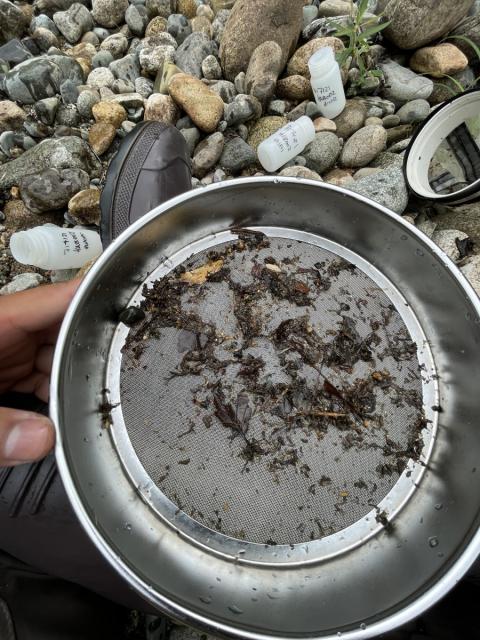
Collected drift net product
Over the course of three different workdays, I ran seven different pellets in the bomb calorimeter. Three of these pellets were from the order Trichoptera (Caddisflies), one from the order Ephemeroptera (Mayflies), one from order Plecoptera (Stoneflies), one from order Megaloptera (Dobsonflies), and one from order Diptera (true flies). Data from both field sampling (stream habitat characteristics) and in the lab (macroinvertebrate abundance, size, and energy content) were organized and analyzed using Excel and RStudio (R Core Team 2021). I am currently running further analyses on these data in order to gain a more accurate picture of the available potential energy that can be provided by the prey in each habitat.
To integrate habitat information with macroinvertebrate density data and assess the habitat quality, the program BioenergeticHSC (Naman, et al. 2020) was used. This program incorporates temperature, depth, flow rate, and macroinvertebrate drift density to estimate the net rate of energy intake (NREI; Joules per second), or how much energy a trout can gain in relation to the work put in to obtain that energy, for different sizes of Brook Trout across a range of observed depths and flows. The virtual trout sizes were specified using the wet mass (grams) and the fork length (millimeters), which is the length of the fish from its head to the fork in its tail. These drift foraging models were constructed to represent the smallest trout (mass: 1.5 g, fork length (FL): 4.32 cm), largest trout (mass: 108 g, FL: 21.7 cm), and an average-sized trout (mass: 24.4 g, FL: 11.22 cm). The surface plots and data spreadsheets constructed by the program were saved for further analysis, which was performed in RStudio. We then created a variety of figures to illustrate how maximum NREI varies with season, habitats, temperatures, and knotweed presence. This can help us compare the effects of each of the variables and identify which has the greatest impact on habitat suitability for Brook Trout.
Preliminary Findings
Preliminary results suggest that seasonality (month) and knotweed presence may affect maximum NREI of Brook Trout (Figure 1). The drift foraging models suggest that for small Brook Trout, the habitat was more suitable (as illustrated by higher NREI rates) during the month of June in comparison to July, which could be due to several factors such as changes in water temperature or knotweed presence as the season progressed. Figure 1 depicts the habitats with no large patch of knotweed nearby as having higher maximum NREI, followed by the habitats directly downstream of a large patch, and lastly the habitats within a large patch of knotweed. Therefore, it appears that areas with less knotweed may provide more suitable habitat for Brook Trout.
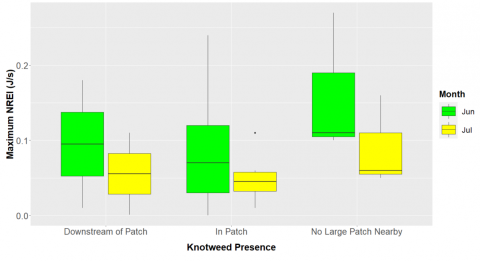
Figure 1. Boxplot depicting the correlation between knotweed presence and maximum NREI (J/s) across the months of June and July 2021 for a simulated small Brook Trout (mass: 1.5 g, fork length: 4.3 cm).
This research is significant for several reasons. First, it complements previous research showing that this invasive knotweed species negatively impacts physical elements of the streamside environment (Hammer 2019). My findings extend to new, biological elements of the stream environment such as macroinvertebrate drift density and Brook Trout foraging capabilities. The drift foraging models I created help to identify which habitats within the study site provide the best net energy gain and would be preferential to trout. In turn, conservation efforts can be focused on these identified habitats to help preserve this important native species.
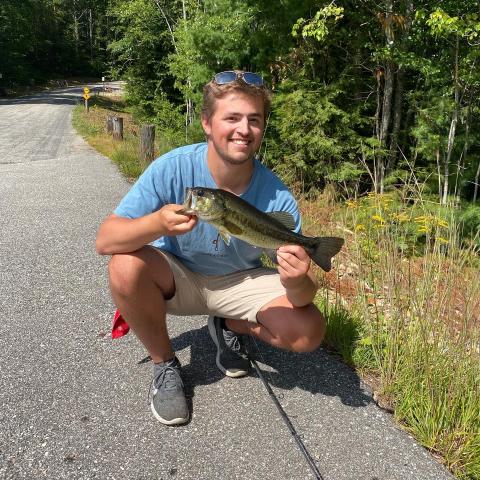
Plans for the Future
Complete results of this study are forthcoming, as I am continuing this project over the academic year. First I will finish running drift foraging models for the virtual average-sized and large trout. Once completed, I plan to analyze the data to determine which of the recorded variables had a significant impact on the max NREI values across the different trout sizes. This is essential to seeing how knotweed affects the NREI values across multiple months as well as over a greater range of trout sizes. I also plan to collect further bomb calorimetry data and troubleshoot the existing data I collected. I will present my findings at the Undergraduate Research Conference during the spring 2023 semester.
I would like to thank Dr. Nathan Furey for all the support and guidance he has provided me as my mentor throughout this research experience. Nathan helped me with many aspects of my research project, for which I am very grateful. His support helped motivate me and was instrumental in my success. I would also like to thank all the members of the Furey Lab who helped me out in different ways throughout the project, both in the field and in the lab. A big thank you to the field technicians Jonathan Truscott and Jon McCoy, for their hard work in the field this past summer and letting me come up and work alongside them for a week. My sincerest thanks to the Hamel Center for Undergraduate Research for awarding me a Summer Undergraduate Research Fellowship (SURF) which allowed me the opportunity to carry out my research. A big thank you to Mr. Dana Hamel, the Class of 1959 Fund for Excellence, and the Class of 1962 Student Enrichment Fund for funding my research and making this all possible.
References
Hammer CF (2019). The Impacts of Terrestrial Invasive Plants on Streams and Natural and Restored Riparian Forests in Northern New England (Masters thesis, University of New Hampshire).
Naman SM, Rosenfeld JS, Neuswanger JR, Enders EC, Hayes JW, Goodwin E, Jowett IG, Eaton BC. (2020). Bioenergetics-based habitat suitability curves for instream flow modelling: introducing user-friendly software and its potential applications. Fisheries, 45: 605-613. https://afspubs.onlinelibrary.wiley.com/doi/10.1002/fsh.10489
R Core Team (2021). R: A language and environment for statistical computing. R Foundation for Statistical Computing, Vienna, Austria. URL https://www.R-project.org/.
Author and Mentor Bios
Matthew Scott, of Westford, Massachusetts, will graduate in May 2023 with a bachelor of science in marine, estuary, and freshwater biology. His Summer Undergraduate Research Fellowship (SURF) project was inspired by his work in Dr. Furey’s lab and a stream ecology course he took in the spring of 2022. This research experience allowed Matthew to dive deeper into the topic and gave him the opportunity to apply concepts he had learned in the classroom. He found this research to be very fulfilling and an important experience that solidified his love for science and nature. He submitted his research to Inquiry with the intention of inspiring other undergraduates to pursue research opportunities through the Hamel Center for Undergraduate Research. Matthew plans to earn a master's degree and doctorate in a field related to fish biology and movement ecology. He also plans to become a professor conducting research, where he will be able to share his knowledge with the coming generations of scientists, to inspire them to conduct research themselves.
Nathan Furey is an assistant professor in the department of biological sciences. He began working at UNH in the fall of 2018. He is a fish biologist who specializes in movement ecology, predator-prey interactions, bioenergetics, and landscape ecology. He also teaches courses in ichthyology, fisheries biology, and stream ecology. Dr. Furey has worked with several undergraduate students in his research, and this is the first time a mentored student of his is publishing their work in Inquiry. He found Matthew’s project to be both satisfying and challenging, and says that this research, linked to field projects with new quantitative components, will allow his research team to ask more powerful questions moving forward. He feels that writing is a critical skill in any scientific profession, and that being able to translate science to a broader audience is essential for science to benefit society.
Copyright 2022, Matthew Scott
